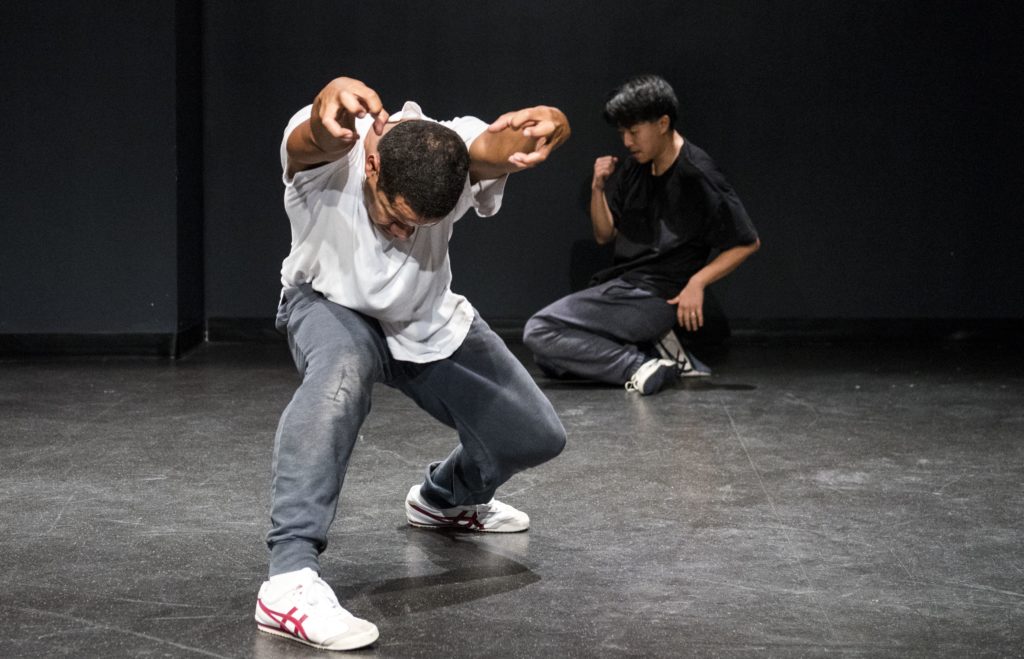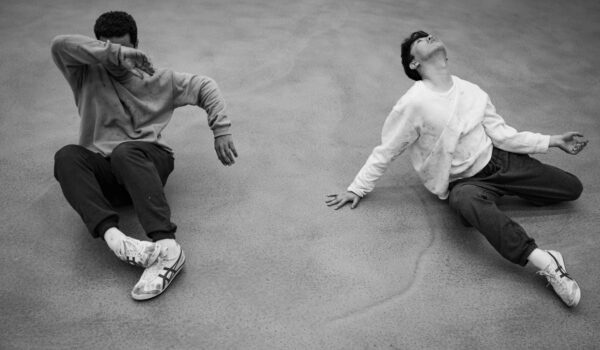How can the body be used as a instrument to say things that go unsaid? This is one of the many questions that Jean Abreu and Naishi Wang’s new work Deciphers asks. Embarking on its international tour of Canada next year, Deciphers uses dance to detail the migrant/immigrant experience.
We caught up with the two of them to find out more about Deciphers ahead of its Canadian tour.
DAJ: Tell us about yourself.
Jean: I am an independent dance artist and I run my own company Jean Abreu Dance. I am originally from Imperatriz-Maranhao in the North East of Brazil and I am based in London. As an artist I am interested in movement and in the body as a departure point to translate human emotions and as a way to honestly articulate the transforming nature of human identity.
Naishi: I’m an independent dance artist based in Toronto, Canada. My artistic journey revolves around the exploration of movement as a meaning to discover and express the essence of the 21st century. I’m originally from China, and I met Jean in 2019.
DAJ: Why did you decide to create Deciphers?
Jean: Naishi and I met online, we started to follow each other and there was a natural connection and attraction for each other’s work as well as shared bodily immigrant experience. And a mutual friend of ours made a kind of official introduction, and after that it was clear our common desire of coming together in the studio. Deciphers was born from this desire of meeting in person.
Naishi: Deciphers is an international collaboration between Canada and the UK. And it all started from a general conversation, when Jean and I realized that we shared some similar aspects in our life journeys. One originally came from China and settled in Canada; the other from Brazil and relocated to the UK, both of us starting as international dance students to become dancers in dance companies, had transitioned into the world of independent choreography in these other countries. Before long our discussion developed into the realm of translating cultural disparities and adaptation, how we realized that the language of dance transcends all barriers.
Jean: And I think it became very clear after our initial conversations that we both were interested in exploring how our personal movement/artistic languages evolved due to us being constantly on the move at such an early stage of our lives, changing and adapting, in order to evolve as artists in our new chosen homes places. So, the transitory and transitional nature of our life journeys became the source of our investigation, to really see the differences in our similar paths… Coming from two big countries, Brazil and China, and moving to new places. That became central in our research.

DAJ: Tell us about Deciphers and the coming-together of different dance styles and mediums (i.e. spoken word, ink).
Jean: Deciphers allowed us to explore the body as our main source and departure point for communication and as a way to connect. But also we were interested in how other mediums of communication are inherently an extension of the body. It is in this context that we wanted to make space for other mediums ,and because it is also part of our individual practices. Movement and Dance is present in every sphere of Brazilian culture and I grew up with that. But officially I begin my training with Brazilian ballroom dance and traditional/folk styles like samba as well as Capoeira ( Brazilian Martial Arts ) all these dance languages has evolved with me to make the movement artist I am today and firmly forms the source material for Deciphers.
Naishi: We wanted to make poetry in Deciphers. So all the elements used, such as spoken world or other medium, is to serve this purpose of making poetry. From my background in Chinese folk dance training, like Mongolian dances, Tibetan dances, Chinese classical dances and Tai-Chi, martial arts and Qigong background, all combined together build the backbone of Deciphers. Aside from dance I also practice visual arts, other elements such as Chinese calligraphy and drawing were part of this poetry creation.
DAJ: What was the making/choreographic process like?
Jean: Deciphers has been a long journey. It’s taking enormous amounts of commitment and focus, especially because it started as a pre-pandemic project. We were supposed to meet when the Covid-19 pandemic hit, when the world completely changed. It forced us to switch the whole process online. Naturally we had to invite other mediums into the work in order to get to know each other remotely. The process has since had multiple iterations in person in Canada and UK, supported and encouraged by organizations on both sides of the Atlantic with lots of scheduling, organising and patience. Constantly negotiating the ongoing process of physical geographical distance and closeness.
DAJ: Dance, as a linguistic tool, enables cross-cultural and intercultural communications. Why do you think dance can do this?
Jean: My perspective on what dance means is something quite plural, present everywhere and shared by all. We experience the world through our bodies first – in a multitude of feelings and sensations – before we can find words to articulate it. To me dance is one of the purest ways to experience emotions because it exists in this wordless space requiring no logical explanation.We often underestimate how much we can understand each other without articulating a single word, and dance as a linguistic tool invites us to feel and create our own experiences of the world and each other across the spectrum, cultures and background without the need of logical sense making. Whilst other linguistic tools heavily rely on logical understanding and sometimes this creates more communication barriers. I know it’s a cliche, but dance really is a universal language.
Naishi: As a body of linguistic poetry, Deciphers also highlights misunderstanding and making nonsense. Unlike other linguistic tools that focus on understanding and making sense, I feel that dance can also try to make nonsense, focusing on the immense potential with connections between the interior or exterior of the human body, which putting into words might not make sense, but they can be translated into movement forms or energy forms or meditative states. While it may not directly provide answers or explanations, dance reflects culture, intercultural communications, and on some level, it amplifies those subjects because we share life experiences and one common body.
DAJ: Your work details the immigrant or migrant experience. Why did you decide to focus on this? What has it been like to tell this story through dance?
Jean: Our immigrant experience became our departure point in this work because it intrinsically informed and shaped our own independent artistic practices. It made sense for us to investigate further these deeply personal journeys using the body to communicate our experiences with the outside world and alongside each other. But not as an attempt to create a logical linear sense but rather creating a poetic journey highlighting the emotions contained inside our individual movement languages and in some ways amplifying what makes us different and yet, the same. Personally, I feel immigration has been a reality in human history for centuries,and we tend to forget that humans are transient beings , migrating through life in our own individual ways.
In Deciphers we expose our own individual migrant experiences expressed through the body as honestly as possible and invite the viewer to find their own path. Sometimes these individual experiences are culturally worlds apart and in many ways Naishi and I are really separate but totally together.
Naishi: We are interested to talk about immigrant and migrant experiences because, first of all, this is also our personal experience. And this is also one of the biggest topics of the 21st century. You know, willingly and unwillingly millions of people leave their countries as migrants, sometimes you have to leave as a refugee seeking for safety and help.
In Deciphers, the body linguistic translation narrows those immigrant experiences on moving from our comfortable home to different countries, becoming the movement inside of us. In my end, of course, we highlight our impressions and abstract emotions through language and movement of the body.
We wanted to highlight the journey, we’re not trying to go exactly the same pattern, but we have our different ways. Like, you know, Jean is Brazilian and moved to the UK, and I’m Chinese, moving to Canada. First of all, the UK and Canada are two different countries. And we come from two very different cultural backgrounds, and we have our own ways of dealing with dance and the body. We have our own answers, we celebrate what is similar in our journeys, but attending to our individual experiences.
DAJ: On this tour you’ll be presenting Deciphers in different places and to different communities. Why is it important for Deciphers to reach those spaces?
Naishi: We’re very excited to premiere this work in Canada. I call Toronto my home, a place with so many different cultures, it’s a very multiculturalist community. And we wanted to bring Deciphers to those diverse cities, those communities and highlight those shared immigrant experiences and connect with those communities. They can see the work in tune with their own experiences.
Dates:
Canada Tour (2024):
Push Festival Vancouver, Canada 26-28th January 2024.
Harbourfront Centre, Toronto, Canada 8-10th February 2024.
Montréal Arts Interculturels, Montréal, Canada 14-16th February 2024.
National Arts Centre, Ottawa, Canada 22-23 February 2024.
Information and tickets: www.jeanabreudance.com/works/deciphers
